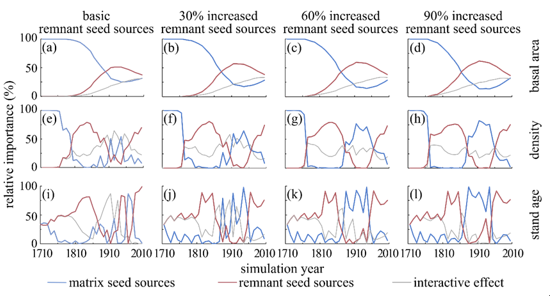Increasing Effects of Remnant Seed Sources on Post-volcanic-eruption Forest Landscape Recovery
Volcano eruption is a catastrophic disturbance, which can destroy almost all forest vegetation, forcing forest succession to restart. Post-volcanic-eruption forest landscape recovery is largely driven by available seed sources and seed dispersal pattern.
Changbai Mountain, northeast China experienced a massive volcanic eruption of explosivity index seven in 946 AD. The eruption was recorded as one of the most powerful eruptions in the last 2,000 years, and is referred to as the “Millennium Eruption”. The lava flow, ejected ash, and triggered wildfires destroyed almost all vegetation within a radius of about 50 km. Matrix seed sources in the volcano-undisturbed forests, together with remnant seed sources that survived the eruption, contribute to the recovery of the forest landscape. Both seed sources have been found important in forest landscape, but their relative importance is rarely quantified.
A research team led by associate Prof. LIANG Yu from the Institute of Applied Ecology of the Chinese Academy of Sciences used a forest landscape modelling approach to spatially reconstruct historic post-volcanic-eruption forest landscape and quantified the relative importance of remnant seed sources and matrix seed sources on forest landscape recovery in Changbai Mountain.
Their work to reconstruct spatial and temporal dynamics of a historic forest landscape is among few such attempts. Model verification suggested that simulated historic forest landscape dynamics have the ability to actually represent historic forest condition in Changbai Mountain.
In this study, the researchers found that matrix seed sources dominated the recovery of basal area and density in the early stage of forest development, while remnant seed sources had only minor effects. Afterwards, the effects of remnant seed sources increased and even exceeded that of matrix seed source over forest recovery.
More notably, the presence of remnant seed sources resulted in older stands at the early stage of recovery and offered more seeds for the recovery of late-successional species, exerting lasting impacts on forest composition and structure.
The study was published in Landscape Ecology. It was supported by the National Key R&D Program of China, the National Natural Science Foundation of China, and the Joint Fund of National Natural Science Foundation of China.

Fig 1. The relative importance of matrix seed sources, remnant seed sources, and their interactive effect on the total basal area (a–d), total density (e–h) and stand age (i–l) in the disturbed area under the basic and increased remnant seed sources configurations (Image by LIANG Yu).
Publication Name: LIANG Yu et al.
Email: yueqian@iae.ac.cn



